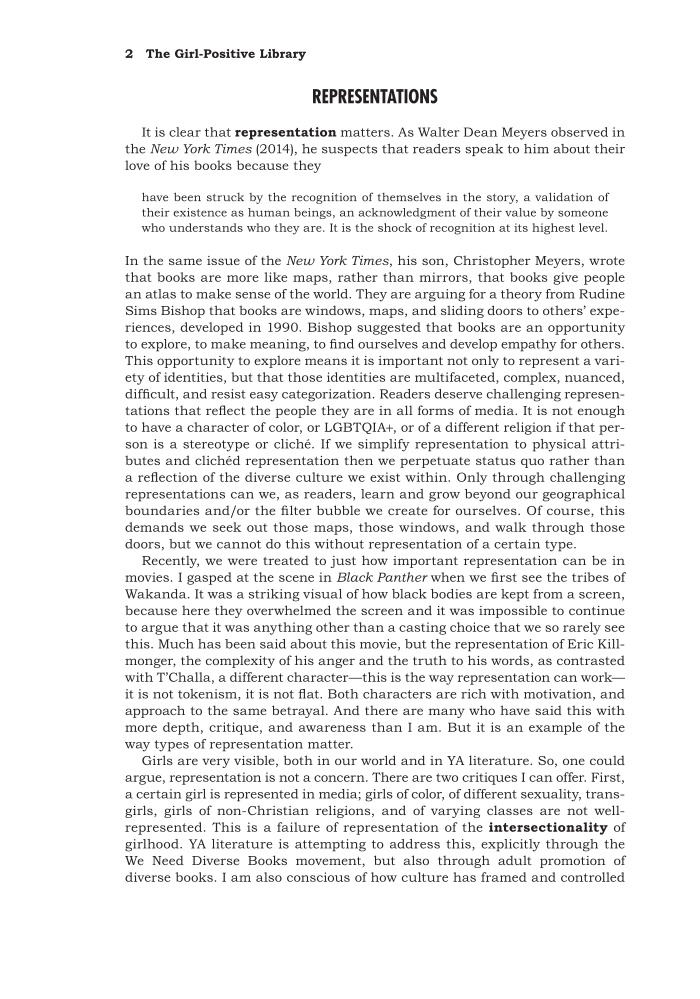2 The Girl-Positive Library REPRESENTATIONS It is clear that representation matters. As Walter Dean Meyers observed in the New York Times (2014), he suspects that readers speak to him about their love of his books because they have been struck by the recognition of themselves in the story, a validation of their existence as human beings, an acknowledgment of their value by someone who understands who they are. It is the shock of recognition at its highest level. In the same issue of the New York Times, his son, Christopher Meyers, wrote that books are more like maps, rather than mirrors, that books give people an atlas to make sense of the world. They are arguing for a theory from Rudine Sims Bishop that books are windows, maps, and sliding doors to others’ expe- riences, developed in 1990. Bishop suggested that books are an opportunity to explore, to make meaning, to find ourselves and develop empathy for others. This opportunity to explore means it is important not only to represent a vari- ety of identities, but that those identities are multifaceted, complex, nuanced, difficult, and resist easy categorization. Readers deserve challenging represen tations that reflect the people they are in all forms of media. It is not enough to have a character of color, or LGBTQIA+, or of a different religion if that per- son is a stereotype or cliché. If we simplify representation to physical attri- butes and clichéd representation then we perpetuate status quo rather than a reflection of the diverse culture we exist within. Only through challenging representations can we, as readers, learn and grow beyond our geographical boundaries and/or the filter bubble we create for ourselves. Of course, this demands we seek out those maps, those windows, and walk through those doors, but we cannot do this without representation of a certain type. Recently, we were treated to just how important representation can be in movies. I gasped at the scene in Black Panther when we first see the tribes of Wakanda. It was a striking visual of how black bodies are kept from a screen, because here they overwhelmed the screen and it was impossible to continue to argue that it was anything other than a casting choice that we so rarely see this. Much has been said about this movie, but the represen ta tion of Eric Kill- monger, the complexity of his anger and the truth to his words, as contrasted with T’Challa, a different character—this is the way represen ta tion can work— it is not tokenism, it is not flat. Both characters are rich with motivation, and approach to the same betrayal. And there are many who have said this with more depth, critique, and awareness than I am. But it is an example of the way types of representation matter. Girls are very visible, both in our world and in YA literature. So, one could argue, represen ta tion is not a concern. There are two critiques I can offer. First, a certain girl is represented in media girls of color, of different sexuality, trans- girls, girls of non-Christian religions, and of varying classes are not well- represented. This is a failure of representation of the intersectionality of girlhood. YA literature is attempting to address this, explicitly through the We Need Diverse Books movement, but also through adult promotion of diverse books. I am also conscious of how culture has framed and controlled
Document Details My Account Print multiple pages
Print
You have printed 0 times in the last 24 hours.
Your print count will reset on at .
You may print 0 more time(s) before then.
You may print a maximum of 0 pages at a time.













































































































































































